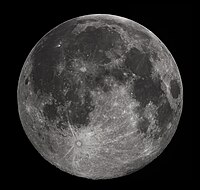
Photo from wikipedia
Abstract We investigated solar flares partially occulted by the solar disk observed by the Yohkoh satellite. We found that about 30–40% of them show quasi-periodic pulsations (QPPs) in hard X-rays… Click to show full abstract
Abstract We investigated solar flares partially occulted by the solar disk observed by the Yohkoh satellite. We found that about 30–40% of them show quasi-periodic pulsations (QPPs) in hard X-rays (HXR). A lack of usually brighter footpoint sources allowed us to reconstruct coronal HXR sources with a higher quality. We analyzed 28 partially occulted flares showing the QPPs and for the first time present results for such events as a group. In our opinion, the majority of the observed HXR loop-top sources can be explained as successive compression and rarefaction of magnetic traps described in a model of oscillating magnetic traps (OMT). In this model a particular value of a ratio between the diameter of traps and the period of pulsations is postulated. In our modification of this model, different values of the ratio are possible, with the exception of a lower range, where low values of magnetic field strength and high values of electron density number can excess the plasma- β parameter above unity (ballooning instability).
Journal Title: Advances in Space Research
Year Published: 2019
Link to full text (if available)
Share on Social Media: Sign Up to like & get
recommendations!